Marcia Thornton Jones's Blog, page 38
January 14, 2023
What's the Point?
Recently, my MFA students asked a common question, what’s the point? We began the discussion after reading two interesting reports. The first is published by Author’s Guild in2020. Christine Larson, Ph.D., assistant professor of journalism at the University of Colorado, studies the impact of technology on media workers and culture industries. “But the days of authors supporting themselves from writing may be coming to an end. The changing economy of publishing today means that reliable income and time—the metaphorical room for writing—are increasingly out of reach for many authors.”
The second is offered by Sarah Nichols in her 2021 report posted on one of my favorite blogs, Book Riot. According to Nichols, it all depends. She crunches the numbers, comparing incomes for self-published and traditionally published authors.
“… people tend to be deeply unsatisfied with my “it depends” answer. There is no way to predict how much a book will make, but I spoke with 15 authors of all stripes to demonstrate the variety of options. I spoke with self-published authors and traditionally published authors who have made less than they spent on expenses, authors of both paths who easily make a living off their writing, and everyone in between.”
For my response, I returned to an old favorite, a steady, inspirational read by Christopher Vogler, The Writer’s Journey (Michael Wiese Productions, 1992), and one of my favorite discussion topics.
While the book explores the monomyth, made famous by Joseph Campbell, and its impact in the storytelling process, Vogler expands the myth to include the writer herself. Every storyteller bends this archetypal pattern to her own purpose or the needs of her culture. That’s why the hero has a thousand faces, states Vogler. But at the heart of the story is always a journey.
The hero’s journey, you may remember, is found in all sorts of storytelling, most especially in adolescent and young adult. The profound truth of adolescence is the separation from parent, the search for uniqueness and the triumphant integrating into wholeness – the return to being. You can see how this hero’s journey is mapped out in J. K. Rowling’s Harry Potter and the Sorcerer’s Stone, Lois Lowry’s The Giver, and Rick Riordan’s The Lightning Thief.
Writers go on a similar journey, states Vogler. In fact, as he states, “The hero’s journey and the writer’s journey are one and the same.”
Writing is certainly hard work, “a perilous journey inward to probe the depths of one soul.” It is a fearsome process, no matter how many books one has under their belts. Sue Grafton, author of the wildly popular Kinsey Millhone Alphabet Series, once stated, “Most days when I sit down at my computer, I’m scared half out of my mind.” The mighty Stephen King noted, “I’m afraid of failing at whatever story I’m writing – that it won’t come up for me, or I won’t be able to finish it.” Even the mythic J.R.R. Tolkien said, as the first book of his iconic series was published, “It is written in my life-blood…I am dreading the publication, for it will be impossible not to mind what is said. I have exposed my heart to be shot at.”
So why write, we ask ourselves? We go through all this agony! What’s the point?
Says Mary Karr (The Liar’s Club), “I write to dream; to connect with other human beings; to record; to clarify; to visit the dead. I have a kind of primitive need to leave a mark on the world.”
Vogler shows that anyone – new as well as established writers – who sets out to write a story encounters all the trials and tribulations, joys and rewards of the hero’s journey.
A writer encounters her trickster, taking shape as computer problems, doctor appointments and time management issues, and other “enemies of the status quo that also bring perspective on the process.
A writer meets the grumpy threshold guardian in the form of our inner and relentless judgments of our work. The tension rises as we face the searing remarks of a reviewer, a copyeditor, an agent, or an editor. And finally, we cross the Rubicon. We are published.
But the journey is just beginning, as we “fully enter the mysterious, exciting Special World” of a published writer. The ordeals become all the more exhausting as we face deadlines and revisions and constant rejections. As we build our platforms and speak – holy moly! – to readers. And our beloveds go out of print, and favorite editors retire, and the rise of the internet dragons.
Along the way, if we are lucky, we meet our sidekicks, our Dr. Watson, our Rory and Amy, our Hermione Granger, our Samwise Gamgee. Sometimes, we meet our Dumbledore or Gandalf wielding his magic purple crayon, the sage who gives advice, who tells us to keep going.
Just keep swimming. Don’t give up.
Take hope, states Vogler, “for writing is magic. Even the simplest act of writing is almost supernatural…We can make a few abstract marks on a piece of paper in a certain order and someone a world away and a thousand years from now can know our deepest thoughts. The boundaries of space and time and even the limitations of death can be transcended.”
--Bobbi Miller
Being a "Gatekeeper" -- by Jennifer Mitchell
As a teacher, I could be considered as a “gatekeeper” of knowledge. I think being considered a gatekeeper could be viewed as negative, in some cases, so I'll try to put my own spin on it. Though I have a road map of where I want to guide a student with their education through the course of the year, I also want to give them ownership on how they achieve that. Seeing students learn and grow is a rewarding part of the job. It is even more fulfilling when they go beyond the seeds that I try to plant when instructing them. When education took an odd turn during the pandemic and students were learning from home. We, as a nation, weren’t prepared to give students a perfect learning environment remotely and it became difficult, as a "gatekeeper" to share information in ways students could truly benefit from. When students came back it was a challenge to get them to the level we knew they needed to be (to be prepared for the next grade). It has taken about 2 years, but I think we are finally seeing the educational gaps closing that the pandemic brought about. The excitement of finally seeing proficient readers or students becoming problem-solving mathematicians is so refreshing.
 Following the "Road Map" of Teaching
Following the "Road Map" of TeachingAnother exciting part of my job as a “gatekeeper” is having students who are majoring in education from the local university come work and observe in my class. Hopefully by watching and working with students, prior to having their own class, they are learning tools and strategies to become better educators. It is my belief that effective educators are always learning and growing; with all of my years in education, I hope these students can pick up something valuable that they can implement into their future classes.
Jennifer Mitchell -- 3rd Grade teacher in the Kansas City Area
January 12, 2023
MY BOOK REVIEWS FOR 2022 by Darlene Beck Jacobson
Happy New Year!
I'd like to begin 2023 by posting a list of all the MG books I reviewed in 2023. In no special order, here they are:
1. EACH OF US A UNIVERSE (MG) by Jeanne Zulick Ferruolo
2. ABSURD WORDS (MG) by Tara Lazar
3. BIRDIE’S BILLIONS (MG) by Edith Cohn4. MIGHTIER THAN THE SWORD (MG) by Rochelle Melander
5. AFRICAN TOWN (YA) by Irene Latham & Charles Waters
6. SHADOW GRAVE (MG) by Marina Cohen
7. THE WOMAN WHO SPLIT THE ATOM (MG) by Marrissa Moss
8. I WILL PROTECT YOU (MG) by Av Mozes Kor & Danica Davidson
9. CABBY POTTS: DUCHESS OF DIRT (MG) by Kathleen Wilford
10. DUET (MG) by Elise Broach
11. CLARICE THE BRAVE (MG) by Lisa McMann
12. WOMEN WHO CHANGED THE WORLD (MG) by Rachelle Burk
13. ODDER (MG) by Katherine Applegate14. ALONE (MG) by Megan Freeman
15. SHIPSHAPE (MG) by E. E. Dowd
16. THE LAST SHADOW WARRIOR (MG) by Sam Subity
17. GOOD DIFFERENT (MG) by Meg Eden Kuyatt
18. THE DREAMS OF SINGERS AND SLUGGERS (MG) by Antoinette Truglio Martin
Some of these books have been featured on SMACK DAB posts,. All of these books were memorable for different reasons and all deserved to be shared with the reading world. What better way to show authors you love their books than to leave a short review.
HAPPY READING!

Darlene Beck Jacobson loves reading great books and posting reviews about them. She also enjoys reading reviews for her own books.
January 11, 2023
The Door Exercise from Jody Feldman
Dear Writers, Teachers of Writers, or Any Creative Types,
As I embark on a big revision of my WIP, I'm finding opportunities but, also, sticking points. So, let's haul out The Door Exercise, something I devised for just these times. Here we go.
Let's say we have a scene that's stale, stagnant, or otherwise static. Something's missing. Some spark. Some life. Some excitement. What do we do? We can either sit there and let that wheel of death spin endlessly in our minds. Or we can answer a knock at the door.*

Knock, knock!
Don't even ask who's there.
Just open the door, and answer this:
What path would this scene take if, on the other side, is...
...your best friend?
...a stranger?
...an enemy?
...a famous singer?
...an unexpected delivery?
...a salesperson?
...a police officer?
...a charity collector?
...the subject of an Amber Alert?
...an Aztec warrior?
...a flock of pigeons?
...nothing?
You get the idea. Go ahead. Choose an option. Or pull out an idea from a hat. Pull out two or three. See what happens. See what magic you can make. Because we all can make magic.
*Your character(s) do not actually need to be behind a door. Are they at the beach? Who peeks around the umbrella? At a restaurant? Who serves their food? At an amusement park? Who's taking tickets? You get the idea.
Today, behind Jody Feldman's door was a librarian asking when her next middle grade is coming out. "Believe me," she said, "I'm working on it!" Meanwhile, The Seventh Level and The Gollywhopper Games series are still bringing her into schools to meet with readers. Want to get in on the fun? Contact her: jody@jodyfeldman.com
January 8, 2023
PASSING THROUGH THE GATES -- by Jane Kelley
I'll be honest. 2022 was not great. When January 2023 arrived, I hoped the new year would bring better things. January gets its name from Janus, the Roman god of doors and gates. That sounds like a good thing. Except doors and gates don't always swing open. Did I really want to blog about the gatekeepers who seem to find new ways to say no?
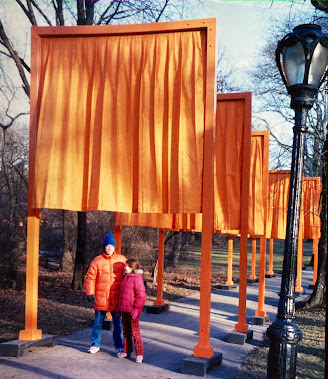
For two weeks in February 2005, these arches suspended huge panels of saffron colored vinyl. The artists Christo and Jeanne-Claude designed and funded the installation. They intended the work to echo Japanese torii gates that were placed at the entrance to Shinto Shrines to mark a transition from mundane to sacred.
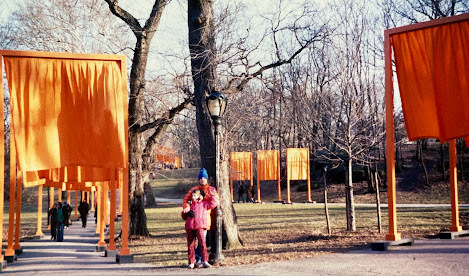
Christo and Jeanne-Claude faced huge challenges. The work itself was monumental. It demanded 5,390 tons of steel, 315,491 feet of vinyl tubing, 99,155 square yards of fabric, and 15,000 sets of brackets and hardware. But before any of that could begin, the artists had to persuade the City of New York and the Parks Department to allow the project. That only took 26 years.
After it was completed, critics sneered. "Why spend $20 million dollars to ruin the Park with curtains that no one in their right mind would even hang in the shower?"
Yes, even these Gates had to get past gatekeepers.
Fortunately for me, and 4 million others, Christo and Jeanne-Claude persisted. They changed their design to answer some concerns about digging holes in the Park. They waited until they had political support. Eventually, they succeeded.
My husband, daughter, and I visited the Gates many times. Central Park was a familiar place for us. But we eagerly wandered along paths that had been transformed by the bright colors.
It was a time of transformation for me in other ways too. I had been trudging along, trying to find a way to live a creative, productive life. I had not made the transition from mundane to the sublime. But in December of 2004, I had signed my first book contract with an educational publisher in New Zealand. That piece of good news made me confident that I was on the right path. Now it seemed my way was marked by glorious flags.
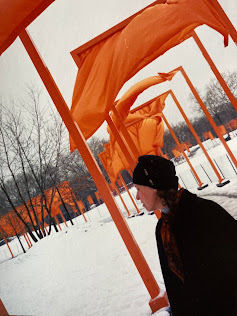
And so, this January, I wish for you orange banners instead of naysayers. And gates that aren't impediments, but transitions from the mundane to the sublime. Hopefully your projects will not take 26 years to come to fruition.
Jane Kelley is the author of many middle grade novels and four math mysteries that gave her the courage to persist.
@font-face {font-family:"Cambria Math"; panose-1:2 4 5 3 5 4 6 3 2 4; mso-font-charset:0; mso-generic-font-family:roman; mso-font-pitch:variable; mso-font-signature:3 0 0 0 1 0;}@font-face {font-family:Calibri; panose-1:2 15 5 2 2 2 4 3 2 4; mso-font-charset:0; mso-generic-font-family:swiss; mso-font-pitch:variable; mso-font-signature:-520082689 -1073697537 9 0 511 0;}p.MsoNormal, li.MsoNormal, div.MsoNormal {mso-style-unhide:no; mso-style-qformat:yes; mso-style-parent:""; margin:0cm; mso-pagination:widow-orphan; font-size:12.0pt; font-family:"Calibri",sans-serif; mso-ascii-font-family:Calibri; mso-ascii-theme-font:minor-latin; mso-fareast-font-family:Calibri; mso-fareast-theme-font:minor-latin; mso-hansi-font-family:Calibri; mso-hansi-theme-font:minor-latin; mso-bidi-font-family:"Times New Roman"; mso-bidi-theme-font:minor-bidi;}.MsoChpDefault {mso-style-type:export-only; mso-default-props:yes; font-family:"Calibri",sans-serif; mso-ascii-font-family:Calibri; mso-ascii-theme-font:minor-latin; mso-fareast-font-family:Calibri; mso-fareast-theme-font:minor-latin; mso-hansi-font-family:Calibri; mso-hansi-theme-font:minor-latin; mso-bidi-font-family:"Times New Roman"; mso-bidi-theme-font:minor-bidi;}div.WordSection1 {page:WordSection1; @font-face {font-family:"Cambria Math"; panose-1:2 4 5 3 5 4 6 3 2 4; mso-font-charset:0; mso-generic-font-family:roman; mso-font-pitch:variable; mso-font-signature:3 0 0 0 1 0;}@font-face {font-family:Calibri; panose-1:2 15 5 2 2 2 4 3 2 4; mso-font-charset:0; mso-generic-font-family:swiss; mso-font-pitch:variable; mso-font-signature:-520082689 -1073697537 9 0 511 0;}p.MsoNormal, li.MsoNormal, div.MsoNormal {mso-style-unhide:no; mso-style-qformat:yes; mso-style-parent:""; margin:0cm; mso-pagination:widow-orphan; font-size:12.0pt; font-family:"Calibri",sans-serif; mso-ascii-font-family:Calibri; mso-ascii-theme-font:minor-latin; mso-fareast-font-family:Calibri; mso-fareast-theme-font:minor-latin; mso-hansi-font-family:Calibri; mso-hansi-theme-font:minor-latin; mso-bidi-font-family:"Times New Roman"; mso-bidi-theme-font:minor-bidi;}.MsoChpDefault {mso-style-type:export-only; mso-default-props:yes; font-family:"Calibri",sans-serif; mso-ascii-font-family:Calibri; mso-ascii-theme-font:minor-latin; mso-fareast-font-family:Calibri; mso-fareast-theme-font:minor-latin; mso-hansi-font-family:Calibri; mso-hansi-theme-font:minor-latin; mso-bidi-font-family:"Times New Roman"; mso-bidi-theme-font:minor-bidi;}div.WordSection1 {page:WordSection1;}
January 4, 2023
Interview with Shirley Miller Kamada, author of No Quiet Water
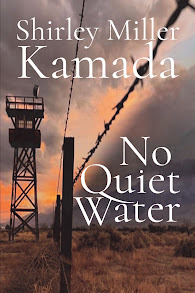
1. I always start with the most obvious request: Please give us a one-sentence synopsis for No Quiet Water.
No Quiet Water is a coming-of-age story about a 10-year-old Japanese American boy, Fumio, who is forced into an internment camp with his family during WWII, and his loyal dog, Flyer, who was left behind.
2. Please tell us a bit about the real-life inspiration behind No Quiet Water.
Two years after I married my husband, Jimmy Kamada, I learned of his family’s World War II internment experience. They were incarcerated first in Puyallup at Camp Harmony, and then in Idaho’s Camp Minidoka. His parents were born in Seattle. They were citizens. Realizing I knew nearly nothing about the internment, I began my research. Much of what I learned I felt I should share.
To inspire in a reader a visual image is an effective way to convey the true nature of a situation. “What happened? How did that look?” My hope is to gently urge the reader to ask, “And how did that feel?”
3. I was pleasantly surprised by the first chapter from Flyer’s POV. What brought you to telling the story (at least in part) from the eyes of the farm dog?
When No Quiet Waterwas still a pup of a story, I was invited to visit Rockin’ Bar Border Collies, where Rod and Debbie Goodwin raise and train these super-intelligent animals. I knew that a border collie—Flyer—must be a primary voice. Flyer, rescued as a pup by Fumio’s grandfather, remained with family friends, the Whitlocks, on Bainbridge Island when the Miyotas were forced to leave.
Border collies are not fighters. It is their nature to "gather together” not only sheep, but ducks and geese and, sometimes, children. Even young dogs have a keen sense of who to trust, and those trusted by a dog feel favored. Border collies are intensely loyal.
Those who would like to know more about border collies will find an article and a video from “On the Lamb Herding” on my website.
Is a Border Collie the Pet for You? | Shirley Miller Kamada
4. Please tell us a bit about the level of distrust / suspicion of espionage regarding Japanese Americans during this time, and how that shows up in the book.
One of the quotes that resonated with me was when Fumio thinks, simply, “It’s our war.” And yet, they were treated as enemies in their own country. Can you speak to this a bit–how it resonates through the book and your conversations with those who remember the internment camps?

At ten years of age—the very age at which, in my teaching days, classroom Social Studies lessons centered on United States history—Fumio understood that he and his family had been targeted and betrayed by their own country. Community leaders of Japanese heritage were quickly taken into custody after the bombing of the fleet in Pearl Harbor. Records show that the government had, for decades, tracked Japanese Americans who had any sort of influence.
In No Quiet Water, Fumio’s friend Joey’s father was taken from the family home and consigned to a Justice Department camp because he was president of the island’s Farmers Association, despite that he had promoted raising additional crops to help the Allied war effort.
Fumio would have known that Japanese Americans already serving in the military had been reassigned to lower-level duties. Soon, Japanese Americans would not be accepted for military service. Finally, they were drafted and those who did not report were jailed.
I am interested in the question, “How does this resonate in conversations with those who remember the internment?” but I cannot answer it directly. Those who were adults in camp locked the memories in compartments they seldom opened. My husband has said the camps were not discussed even among family. There was a silent agreement: Let the past be the past.
5. One of the most inspiring parts of the book is the attempt to find or make beauty even in such difficult times. Why did you choose drumming specifically?
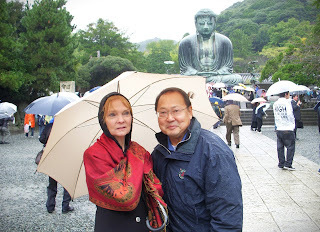
Visiting Japan to see relatives, Jimmy and I were thrilled to find that KODO, a world-renowned taiko group, was performing near our hotel. The taiko drummers were friendly. Youngsters in the audience were encouraged to try instruments. The performance was uplifting. The drumbeat became the heartbeat of those gathered.
Intrigued, I found Heidi Varian’s authoritative book, The Way of Taiko.
Taiko drumming is over a thousand years old. Author Heidi Varian has written, “The taiko drum makes so powerful a sound that in ancient times it was said the boundaries of a Japanese village were determined by how far the sound of the village drum carried. … The taiko symbolized community.”
My inclusion of ensemble taiko drumming was an artistic decision. In the 1940s, the drums accompanied Obon ceremonies, and they were used to provide rhythm for the study of martial arts. Ensemble taiko performances are cited as having appeared in 1951. My belief is that growth toward ensemble performance began earlier, and Fumio would have found the dojo both a haven and a place of growth.
6. I thought it was interesting that there were such different ideas about what needed to be done: those who only wanted to do what was asked, those who wanted peaceful protests (writing to government officials, contributing editorials, working to prove good citizens), and those who wanted their resistance to be seen.
I’m glad to address this question! This is a key consideration in our understanding of the actions of Japanese Americans living in the military zones of the western United States.
Younger generations, especially, ask, “Why didn’t Japanese Americans protest? Why didn’t they push back?” It’s important to know that they did protest, but not in ways we might identify as such today.
Those who were to be interned had few options. Strict curfews were put in place and travel was disallowed. Bank accounts were frozen. For a brief time, they were given the choice to move out of military zones, but permission was rescinded abruptly, and only a very small number were able to do so.
A priority for most Japanese Americans was the health and safety of their families. They felt that the most effective way to prove themselves “good Americans” was to live as Americans, to demonstrate American values, trusting that the government had their best interests at heart. Prejudice, though, was rampant and was turned to profit-making by those who chose to leverage it, building barracks and installing facilities to isolate Japanese living in the country legally and, also, United States citizens.
As one form of resistance, letter writing campaigns were launched, notably by women such as Mothers of Minidoka, urging that their sons not be drafted from internment to the military, but to first acknowledge their rights as citizens and free them and their families.
Nina Wallace, with Densho, The Legacy Project, writes, “The First Lady was the only person to respond to the Mothers’ Society of Minidoka petition in a hurried letter dictated to a secretary because ‘Mrs. Roosevelt had to leave before signing.’” Responses to letters of petition from other women’s organizations “ranged from curt to patronizing to vaguely threatening,” such as one from Dillon Myer that “simultaneously thanked the mothers for their ‘devotion… to the democratic principles’ and warned them against ‘indicating reluctance to contribute to the winning of the war.’” Imagine, this in response to a letter.
An example of perhaps more active resistance, regarding conditions at Camp Minidoka: On January 6, 1944, seventy-five Issei and Nisei women marched on the offices of Assistant Project Director R.S. Davidson and held an eight-hour sit-in, demanding that camp administrators meet with striking boilermen and janitors and restore hot water to the camp. This effort by the women met with success.
The protests of the 1960s were more publicly visible. Yuri Kochiyama took inspiration from Malcolm X whom she met in October 1963. Her subsequent activism was admittedly controversial. We see in it, though, how resistance to human rights violations changed in later years.
7. Where will your writing take you next?
I have begun a novella in which Fumio’s best friend Zachary Whitlock will, in his own words, tell about his experiences as a youth on Bainbridge Island during World War II. Zachary’s family belonged to the Friends Church, a Peace Church. I am drawn to delve into his perspective. I want, also, to follow his path to adulthood and consider how his early experiences influenced his later life.
# # #
Related to Question 3: Rockin’ Bar Border Collies, Rod and Debbie Goodwin,https://rockinbarbordercollies.com/
Related to Question 5: The Way of Taiko, Heidi Varian, Stonebridge Press, Second Edition, 2013.
Related to Question 6: A Brief History of Japanese American Relocation During World War II (U.S. National Park Service) (nps.gov)
and
[JKaSM1]TY. I didn't want to lose the concept, but I knew "affective" was a downer.
[PC2]I’m just removing words wherever I can.
[JKaSM3]TY - I'm realizing in myself a tendency to reiterate and reinforce. A hold-over from El. Education days. Say it three times, using different words each time.
~
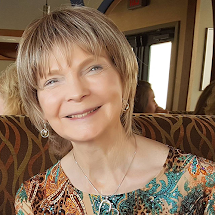 You can keep up with Shirley Miller Kamada at her author site, and order No Quiet Water here.
You can keep up with Shirley Miller Kamada at her author site, and order No Quiet Water here.
January 2, 2023
New Year, New Middle Grade Fiction
New Year, New Middle Grade Fiction
Middle grade fiction selections for the new year! I’ve had the pleasure of interviewing some great middle grade authors over the past month on my blog Book Q&As with Deborah Kalb, and here are some excerpts…
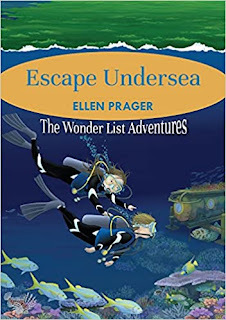
Ellen Prager’s new novel, Escape Undersea, is part of her Wonder List Adventures series; this book features an undersea lab. Prager, a scientist who worked in such a lab, said: “I hope readers of all ages can escape into the story, learn about the undersea world, relate to the characters and their issues, and laugh. As in the other books, there’s plenty of humor involved, so I hope readers will have fun while they learn.”
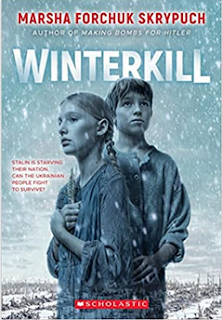
Marsha Forchuk Skrypuch’s timely new novel, Winterkill, is set in Ukraine in the 1930s. “I was doing the final edits for Winterkill on Feb. 24 [when Russia invaded Ukraine],” Skrypuch told me. “I feel absolutely sick to my stomach how accurately Winterkill predicts and depicts the current war, even down to its title, as Russia uses the cold of winter as another weapon from his genocidal toolbox.”

Caroline Brooks DuBois’s new novel in verse, Ode to a Nobody, focuses on a girl whose life is upended by a tornado. “I hope [readers] witness Quinn finding what makes her happy,” DuBois said. “In turn, I hope readers find what makes them happy—whether it’s writing, painting, dancing, kickboxing, rock collecting, or something else…Everyone has their own magic—even if they can’t see it yet.”
 Meira Drazin’s new novel, Honey and Me, looks at the friendship between two girls. “One of the main character arcs of the novel is Milla needing to realise that as much as she admires Honey with her brash, can-do, not-overthinking-it attitude, she provides just as much to the friendship as Honey does, and that Honey admires her right back,” Drazin said.
Meira Drazin’s new novel, Honey and Me, looks at the friendship between two girls. “One of the main character arcs of the novel is Milla needing to realise that as much as she admires Honey with her brash, can-do, not-overthinking-it attitude, she provides just as much to the friendship as Honey does, and that Honey admires her right back,” Drazin said.

Nancy Tandon’s new novel, The Ghost of Spruce Point, is set in Maine. Tandon said: “In this story in particular, the setting was paramount, and I meant for it to become almost a character on the page. But with anything I’m writing, I love to bring sensory elements onto the page, so setting is always important to me.”
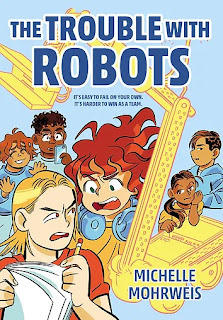
Michelle Mohrweis’s new novel, The Trouble with Robots, focuses on a group of kids in a school robotics club. “When I wrote The Trouble with Robots, I didn’t necessarily mean to write a girl power type STEM book. I just liked writing female presenting main characters, and I liked robotics, so the two fit together naturally for me,” Mohrweis said.
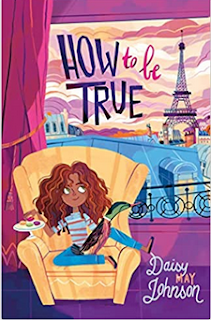
And last but not least, Daisy May Johnson’s new middle grade novel, How to Be True, is set in Paris. “Edie is passionate and heartfelt and lives her life at the edge of the world,” Johnson said of her protagonist. “She's also influenced a lot by my childhood holidays in France and the way I adored wandering around the supermarkets and looking at all the new and exciting food.”
There’s a lot to feast on here, so enjoy! And happy new year!
--Deborah Kalb
@font-face {font-family:"Cambria Math"; panose-1:2 4 5 3 5 4 6 3 2 4; mso-font-charset:0; mso-generic-font-family:roman; mso-font-pitch:variable; mso-font-signature:3 0 0 0 1 0;}@font-face {font-family:Calibri; panose-1:2 15 5 2 2 2 4 3 2 4; mso-font-charset:0; mso-generic-font-family:swiss; mso-font-pitch:variable; mso-font-signature:-536859905 -1073732485 9 0 511 0;}p.MsoNormal, li.MsoNormal, div.MsoNormal {mso-style-unhide:no; mso-style-qformat:yes; mso-style-parent:""; margin:0in; mso-pagination:widow-orphan; font-size:16.0pt; font-family:"Times New Roman",serif; mso-fareast-font-family:Calibri; mso-fareast-theme-font:minor-latin;}.MsoChpDefault {mso-style-type:export-only; mso-default-props:yes; font-size:16.0pt; mso-ansi-font-size:16.0pt; mso-bidi-font-size:16.0pt; mso-fareast-font-family:Calibri; mso-fareast-theme-font:minor-latin;}div.WordSection1 {page:WordSection1;}
December 25, 2022
The Best Gift (Holly Schindler)
 I'm convinced the greatest gift you can give or receive is the gift of time.
I'm convinced the greatest gift you can give or receive is the gift of time.I got that gift, when I graduated with a master's degree back in '01. My family offered to support me while I got my writing career off the ground. I had time to write. Time that never would have been mine otherwise.
It has made all the difference. Everyone is different, and certainly the vast majority of writers get there while working additional full-time jobs. In my case, I'm convinced my writing career would have most likely never materialized without this gift.
The older I get, the more I realize that the gift of time doesn't have to be so grand. It can be as simple as sharing a cup of coffee. Calling a friend to ask how they are. Taking a moment to write an email. Listening--and giving your full attention--to an acquaintance who wants to tell you a story.
It's all important. In my experience, it's extra sweet when you receive one of these smaller gifts of time from someone you hardly know. And it's an especially painful hurt that accompanies a supposed friend not finding a few moments to devote to you. (How we can all be pained by the chronic, "I'm too busy!" excuse that mostly feels like it's an attempt to cover disinterest!)
In 2023, make it a point not to be too busy. Listen and share and reach out. Check in on a neighbor. Wish a coworker a happy birthday. Send someone a note to tell them you were on their mind.
That's how I'll be spending 2023, too.
December 23, 2022
"The Quality of Imagination" Brings Goodwill: Smack Dab in the Imagination by Dia Calhoun
Not only is a cultivated imagination be helpful to artistic types, but it also helps bring desperately needed goodwill into the world. Smith talks about this as "the sympathetic exercise of the imagination" as Arnold Bennett wrote in his 1911 meditation on Christmas, The Feast of St. Friend by Arnold Bennett
"He [Bennett] suggests a conscious and deliberate giving of oneself, a suspending of one's own point of view and an adoption of the point of view of the other. 'To increase your good will for a fellow creature it is necessary to imagine that you are he.'"
Imagination creates empathy. (So why don't HR job listings seek imaginative skills?) What better to bring light back into dark times? May your New Year be filled with imagination.
December 19, 2022
An Impossible Gift, An Impossible Cure
"And when that happens, I know it. A message saying so merely confirms a piece of news some secret vein had already received, severing from me an irreplaceable part of myself, letting it loose like a kite on a broken string. That is why, walking across a school campus on this particular December morning, I keep searching the sky. As if I expected to see, rather like hearts, a lost pair of kites hurrying toward heaven."
-Truman Capote, A Christmas Memory
Christmas is always a sweet, celebratory season. As a child, I so much looked forward to us cutting down a fresh tree from the back 40 acres. Decorating with my sister, watching her ice skate and seeing our grandmas in the season.
As I ask myself, "What is an impossible gift for me?" my mind immediately flips to "a cure." Which thus makes me feel selfish, as I do want a cure for my own Multiple Sclerosis. I realize it will not come in my lifetime, but I focus on those who will come after me - so they don't have to endure this disease as those of us who have.
Incurable disease leaves me to those who I have lost to diseases with no cure. Breast cancer, testicular cancer, lung cancer. Heart issues. Depression. It is, perhaps, the time of year I miss them all most of all.
These gifts may be impossible, but no less dear to my heart. I will move forward everyday I am blessed enough to see. Every day, writing and reading and still learning. Never forgetting, never losing.
-AM Peaslee



